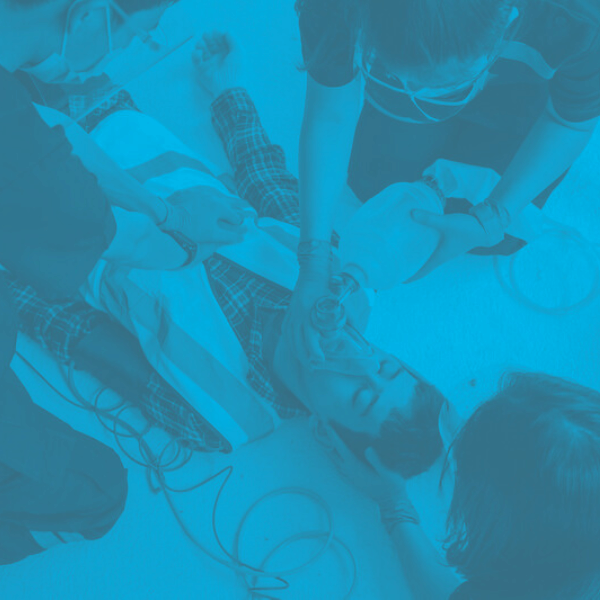Top Reasons Why You Need to Take the ACLS Pretest Now
Why You Need to Take the ACLS Pretest Now

by Greta Kviklyte
Life Saver, AMC
Co-authored by Kim Murray, RN, M.S.
posted on May 14, 2018, at 1:27 pm
Critical care nurses and health professionals understand the value of an advanced cardiovascular life support (ACLS) certification. Unfortunately, being ACLS certified to current standards may not as effective as mainstream experts believe. By some accounts, those in need of ACLS could be subject to errors on the part of caregivers, resulting in increased mortality rates. According to Medscape.com, fewer than 20 percent of in-hospital cardiac arrest cases survive through discharge, but evaluating your ACLS understanding, such as taking an ACLS pretest, may enhance your skill set.
We offer Online ACLS Certification and Renewal
An ACLS Pretest May Highlight Overlooked Errors
 Researchers disagree on the exact number of cases in which mistakes during ACLS administration contribute to decreased mortality. These mistakes may be the result of accidental delays between administering chest compressions, rescue breathing, or medication dosing. Additionally, failure to understand the flow of actions, also known as the ACLS algorithm, in administering advanced support may result in lower recovery rates.
Researchers disagree on the exact number of cases in which mistakes during ACLS administration contribute to decreased mortality. These mistakes may be the result of accidental delays between administering chest compressions, rescue breathing, or medication dosing. Additionally, failure to understand the flow of actions, also known as the ACLS algorithm, in administering advanced support may result in lower recovery rates.
For example, epinephrine can only be given in 1-mg doses after the first administration. Amiodarone may be given for cases of arrest that have not yet responded, but it must be tapered down to 150-mg in subsequent doses to prevent further complication of arrest. Survival hinges on the quality of your BLS and ACLS skills, so reviewing your skills with a pretest may also help identify areas of weakness in your facility, such as outdated equipment or missing supplies in the crash cart.
The Leading Causes of Mistakes in ACLS
Poor planning and lack of experience increase risk for mistakes during ACLS. However, even health care professionals working in critical care may make mistakes when confronted with an emergency situation. The causes of mistakes can also simply be the result of changes in the ACLS algorithm since completing an approved ACLS course.
For example, the AHA updates the algorithm and recommendations for ACLS every five years, if not more often for smaller changes. The last major update took place in 2015, but other studies, as explained by the AHAJournals.org, found that emergency medication technicians (EMTs) should focus more on CPR-ventilation ratios, not just an advanced airway. Although this seems unrelated to ACLS, it means incoming patients may lack an advanced airway if EMS was successfully able to restore a normal heart rhythm. However, the risk of slipping back into cardiac arrest increases with the passage of time, and ACLS in a hospital setting may be more likely to occur.
In fact, lack of understanding of advanced airways actually makes up a leading mistake in performing ALCS, but the root cause, misinformation or failure to have updated credentials within the last year, even if the certification has not yet expired, remains.
Recognizing the Top Mistakes Made in the Chain of Survival
The mistakes of ACLS begin with mistakes made in initiating the chain of survival. A person may enter cardiac arrest unexpectedly, or health care staff may fail to recognize the signs and symptoms of cardiac arrest. Although many facilities now have immediate access to electrocardiogram (EKG) results, a mistake when placing electrodes or poor communication with monitor technicians may lead to inaccurate diagnosis of cardiac arrest. In some cases, a code blue may be initiated on the wrong person due to misinformation.
Another key mistake lies in problems recalling the course of action when providing care. In a hospital setting, the first instinct is to defibrillate. The machine is accessible, and health professionals often turn to the defibrillator first. However, this increases the risk of death. In the chain of survival, performing early CPR supersedes defibrillation. Moreover, this article just noted a critical flaw that’s often overlooked.
Not all rhythms are shockable, and therefore, administering shocks in a non-shockable rhythm only serves to further increase risk of permanent injury and death
Early-defibrillation is only applicable to cases where CPR has started during charging of the AED or when a patient has a known shockable rhythm before initiating the chain of survival. Some of the most prominent mistakes made when administering advanced life support involve misread EKGs. Although today’s technology allows for computer-interpreted results, health care professionals should know how to read an EKG properly, as well as noting the variations in the QRS complex, pre-ventricular contractions, ventricular fibrillation and atrial fibrillation.
The Most Common Mistakes Made When Performing ACLS, Regardless of Assigned Role
The prevalent mistakes of ACLS include failure to recognize key steps in providing advanced life support.
Improper recall of the ACLS Survey. This is the most prevalent mistake in administering ACLS. Health professionals may confuse the chain of survival acronym in basic life support (BLS) and CPR for the ACLS survey. In the ACLS pretest, the majority of participants, 53 percent, incorrectly associate the “D” of ACLS survey with defibrillation. In reality, the correct association with differential diagnosis.
Lack of an advanced airway. An advanced airway is an integral component of high-quality ACLS, but health care professionals may also forget the primary types of advanced airways. For example, a nasopharyngeal airway (NPA) is not an advanced airway; a laryngeal mask airway is an advanced airway. Up to 32 percent of pretest participants miss this question. The problem is not a lack of education, but it does lie in outdated skills and lack of use of ACLS skills in the clinical setting.
Incorrect diagnosis of causes of cardiac arrest. Differential diagnosis is a key difference between ACLS and other life-saving measures. The best-laid plans to restore sinus rhythm and end cardiac arrest fail if the original cause of arrest is not addressed. Those involved in administering ACLS should assess for the most likely cause of arrest first. In addition, health care professionals should treat reversible causes, like blood loss or allergic reaction, and continue providing care, including chest compressions. Less likely causes should be assessed next. Of course, stopping to treat a reversible cause or confirm a diagnosis is acceptable. However, it should take less than 30 seconds to perform these actions.
Forgetting the importance of sterile technique. Administering ACLS is about saving someone’s life, so it is easy to forget the importance of sterile technique. Out of all possible sources of contamination, suctioning via ET tube, near the larynx and lungs, should be subject to maintaining sterile technique. In other words, do not forgo sterile technique; doing so may result in a hospital-acquired infection or even pneumonia.
Overdosing with medications. For example, incorrect administration of epinephrine may result in a greater risk of mortality, as explained by AHAJournals.org. In fact, epinephrine can and should only be administered in 1-mg doses every three to five minutes. However, cardiac arrest that is the result of anaphylaxis may warrant n lower dose of 2 to 10 mcg/min infusion. Furthermore, concentration differences may lead to incorrect dosing. Thus, it is imperative health care staff know the concentration of ACLS medications in their facility and how to properly convert dosing to ACLS requirements in advance of running an actual code.
Inability to determine the best medication to use. There are a handful of medications used in treating cardiac arrest as part of ACLS. These include adenosine, amiodarone, atropine, dopamine, epinephrine, lidocaine, magnesium sulfate, procainamide and sotalol. These medications can be used provided criteria are met for administration. For example, lidocaine should only be used with amiodarone is unavailable, and sotalol should not be used in a prolonged QT interval. If you do not know when to administer each of these medications and their dosages, refreshing your ACLS skills is necessary.
Inaccurately recording all actions in performing ACLS. Although the person recording activities is not actively involved in administering ACLS, he or she plays a vital role in recognizing and preventing mistakes. As a “recorder,” this person should be able to call out the last known doses of medications, as well as their time and prescribed dosage.
Spending too much time with establishing venous access. This final mistake is often associated with trying to find a vein, and in the case of dehydration or swelling, establishing an IV access can be impossible. It is important to remember that if an IV access cannot be established, health care professional should move to another route of administration, an intraosseous access (IO). Furthermore, an IO route is more effective than an ET route. If IV access cannot be established within one minute, move to an IO route.
Review Your ACLS Skills Today
Mistakes will happen, but it is the duty of all nurses and health care professionals to have the most up-to-date and recent information before performing life-saving care and ACLS. If you have not been part of a code blue or participated in an ACLS emergency or drill in the last three months, your risk of making a mistake has increased. Instead of risking a person’s life, take steps now to review, evaluate and enhance your ACLS skills; take your online pretest now.
If you have made another mistake or do not understand one of the more recent changes in administering ACLS, please join the conversation by sharing your concerns on social media, along with this article. In fact, consider renewing your ACLS certification today. It is never too late to learn more about how to perform quality, life-saving care by renewing your certification, even if your certification is not yet up for renewal.



